Thank God the last Clinton-Obama debate is about to happen. 12 minutes from now. A few days and no more listening to that raspy cackly witch-voice. No more looking into those cold steely eyes, or having to discern the real calculation behind those repulsively phony emotional offerings. I realize Barack has to act cool and unruffled like Ronald Reagan in the final debate with Jimmy Carter, but oh, how I would love to see some kind of serious slapdown between them, like that thing they got into in South Carolina.
Envelope Oscar prediction tallies
Now that it’s all over….the winners! “Five Envelope pundits tied for nailing seven predix out of those eight Oscar races: Pete Hammond (The Envelope), Dave Karger (Entertainment Weekly), Mark Olsen (The Envelope), Sasha Stone (AwardsDaily.com) and Jeffrey Wells (Hollywood-Elsewhere.com).
“Of the pundits who voted in all 24 categories, Hammond rules with 17 correct predix, followed by a score of 16 achieved by Edward Douglas (Comingsoon.net) and Jack Mathews (New York Daily News). Those who got 15 right included The Envelope‘s Tom O’Neil, Peter Travers (Rolling Stone), Mark Olsen (The Envelope), Karger and Stone. I didn’t bother to fill out any more than 20 categories so I placed lower. I don’t care. I did okay.
“Pelham” remake
Denzel Washington‘s shaved head and goatee look, evident on last Sunday’s Oscar show, is for Tony Scott‘s The Taking of Pelham 123, a remake of the 1974 Joseph Sargent film.
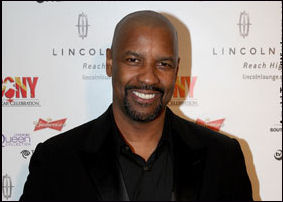
Washington apparently has Walter Mattthau‘s subway administrator role, which he probably wanted as a swing move away from his American Gangster heroin dealer. But I’d rather see him play the Robert Shaw role, which John Travolta has in actuality.
Scott can pull this and that lever and push this and that button, but this new zipped-up version will stand or fall on its own terms based on the merits of David Koepp‘s script. Peter Stone wrote the ’74 version, adpating John Godey‘s novel.
Poor “Charlie Bartlett”
Charlie Bartlett, which opened weakly last weekend, is a smart teen dramedy about an enterprising kid (Anton Yelchin) who peddles prescription drugs and dispenses psychiatric advice on the side. It’s about the spirit of entrepeurialism in the vein of Risky Business, Rushmore and Ferris Bueller’s Day Off, which is to say it’s about a young lad shuffling around with the style and attitude of a likable sociopath.
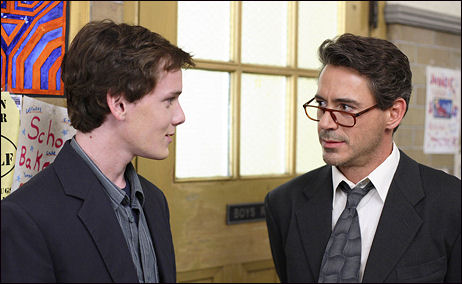
Anton Yelchin, Robert Downey, Jr. in Charlie Bartlett
It was a wee bit disappointing, to me, when Yelchin developed a conscience and a sense of responsibility at the end. Even though this was the right way to go, I prefer the company of nervy rule-breakers. The truth is that for me, Charlie Bartlett is a little tame, a little too well-mannered. And Yelchin is a little too mild, too ready with the twinkly-eyed smile. He’s a skilled actor, but he just doesn’t have the heavy chemistry of a movie star.
The plot ambles along from one thing to another and eventually things reach their end point. Yelchin’s character gets tossed out of prep school (like Rushmore‘s Max Fischer), adjusts to the new rules, becomes a Ritalin dealer, makes new friends, meets a nice sensitive girl and gradually gets laid, gets caught and disciplined, re-assesses, grows up.
And yet Charlie Bartlett, mild and mitigated though it may be, never plays it overly dumb or coy and lowbrow. And the performances are all pretty solid, especially Yelchin’s and Robert Downey‘s as a screwed-down high school principal.
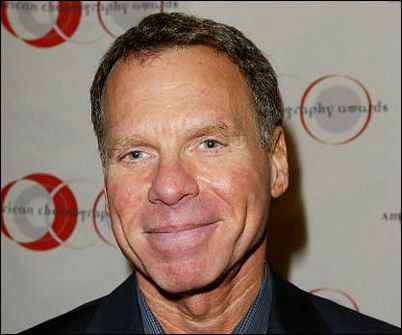
David Permut
There are just two problems. One is that Bartlett got slapped down last Friday by 50% of the Rotten Tomato creme de la creme. The other is that the film opened sixteenth last weekend with a per-screen average of $1636.
This means that no matter how well Bartlett fared in exit polls last weekend, the game is more or less over. It’ll be gone before you know it and a Netflix title three or four months after that. It would be a better world, for sure, if worthy little films like Charlie Bartlett could be given time to find their audience. But we don’t live in it.
I had a nice chat last Thursday with Charlie Bartlett producer David Permut. Definitely a spirited conversation with a good fellow (who’s also the producer of the forthcoming Youth in Revolt, to be directed by Miguel Arteta and star Michael Cera).
I’m sorry I didn’t run the story last Thursday night or Friday, but the rigors of Oscar weekend got the better of me. And I’m sorry that Charlie Bartlett got kicked to the ground last weekend. I wish it were otherwise. You could do worse than to go out and catch it this weekend. But hurry up.
Tuesday tracking
Among this weekend’s openers, The Other Boleyn Girl (being all-media screened tonight) is at 49, 33 and 7…but first-choice is in the teens with women so business could be decent. Penelope is at 52, 25 and 5….fair. Will Ferrell‘s Semi-Pro is polling at 67,35 and 8…modest
The biggest hit of the March 7th weekend will unquestionably be 10,000 BC….73, 29 and 13…pretty good, very male. Roger Donaldson‘s The Bank Job is running at 28, 26 and 1. College Road Trip is now .76, 25 and 4. On March 14th comes Doomsday, currently 30, 17 and 0, Dr. Seuss’ Horton Hears a Who at 62, 32 and 4 and Never Back Down at 26, 29 and 1.
Bogus Frerrell “Interview”
In an imaginary e-mail interview with Semi-Pro star Will Ferrell, Hoboken-based illusionist Dave Lozo, 30, pretends to criticize Ferrell for making the same movie over and over. The irony is that it hits on truths that would never be addressed, much less answered, in a genuine chat with Ferrell. Are made-up interviews preferable? Of course not, but they do seem to get down to things that real interviews sidestep.
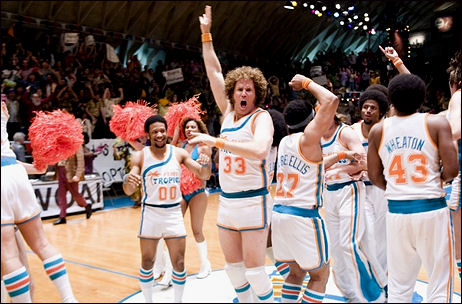
“It seems that all your movies are the same and you have very little range as an actor, yet people continue to go to see your movies,” Lozo says. “In Anchorman, you played a dumb newscaster who takes his shirt off. In Blades of Glory, you play a dumb skater who crams his fat body into tights. In Talladega Nights: The Ballad of Ricky Bobby, you play a dumb race car driver who at some point goes shirtless. All you ever do is play an idiot who shows off his sloppy body. Do you think America will ever get tired of that?”
The imaginary Ferrell says, “Absolutely not. American filmgoers are total idiots. They’ve been going to see the same romantic comedies and action movies for decades, so I see no reason to change up my formula.” And blah, blah, blah.
Lozo then asks, “If you have to summarize yourself and your career in one word, which would you pick — hack, fraud or thief?” To which the phantom Ferrell replies, “Excellent question. I am definitely all three of those things. See me in Wedding Crashers? I never stole a paycheck like I did in that one. I guess I would call myself a frauackief. It’s the only way to sum up my movie career.” Frauackief?
Lozo: “But Will, you were good in Stranger Than Fiction. An all-round solid performance, and you really convinced me you were physically attracted to Maggie Gyllenhaal. Why not take the plunge into more roles like that?
Ferrell: “Are you kidding? You know how much work that takes? After those make-out scenes with Maggie, I had to take a Crying Game shower in my trailer. Sorry, but I’ve got a good thing going here with my current crop of films. Heck, in Ricky Bobby, I didn’t even read the script. I just made up my lines as we went. I bet you didn’t know that.”
Robert Evans in shades. Of course.
“She was a great-looking chick and whatever was in her eyes, it sure wasn’t love. Was I smart? No, I was dumb. With a capital D. Wow, was I dead wrong! I had no idea what was ahead of me. You try to figure a dame out.”

Mind Games, an Oliver Peoples sunglass ad shot as a film noir satire in luscious monochrome, is an agreeable two-minute hoot. It’s also the classiest looking plot-driven film that Robert Evans has ever physically acted in. (Voicing his Comedy Central animated series Kid Notorious doesn’t count, and neither does Brett Morgen‘s The Kid Stays in the Picture, a doc.) It certainly makes Evans seem like a better, more confident actor than he was in the ’50s when he had small roles in The Best of Everything, Man of a Thousand Faces and The Sun Also Rises.
Evans’ costar is Kate Nauta, a 25 year-old model-actress (Transporter 2, The Game Plan) with great gams. The director/style maestro is ad veteran and photographer Sinisha Nisevic.
You’re supposed to know with me telling you that Evans was a legendary studio exec and producer in the ’60s and ’70s (The Godfather, Chinatown, Marathon Man) who suffered a personal and career crisis in the ’80s only to resurge in the early ’90s as a Paramount-based producer and author (“The Kid Stays in the Picture”) while reinventing himself as a kind of iconic-ironic pop figure as the quintessential old-school Hollywood smoothie.
Sean Penn moves on
In this Envelope/’Wire Image photo of Sean Penn and model Petra Nemcova at at Elton John‘s Oscar bash, the caption reads that Nemcova told reporters that Penn “is on the advisory board of my charity.” A comment follows that “we can just imagine what kind of charity advice Sean’s giving her.” That’s what’s known as a none-too-subtle allusion. If I had written the caption, I would have said “we can just imagine the sounds of animal howling and crashing-over furniture and the sharp cry of under-garments being brutally ripped apart.”

Lousy Oscar-cast ratings
The Oscar telecast audience last night was the lowest rated in history. A lousy 32 million viewers tuned in, which is a huge disaster considering that 95.5 million sports fans watched the Super Bowl earlier this month.
This is the way of American culture — more and more followers of competitive games in which men on performance-enhancing drugs try to either hit or take possession of a ball in order to score with it, and fewer and fewer true movie fans. I guess this means…what, ABC might earn a bit less in the way of ad revenues next year? I need to know why I’m supposed to care about this.
Ulrich Muhe was overlooked
I got upset about Roy Scheider being ignored in the Oscar telecast’s death montage (i.e., “in Memoriam”), and Us magazine has gotten riled about Brad Renfro being left out as well. But what about Ulrich Muhe, who gave one of the 21st Century’s greatest performances in The Lives of Others, which is hands down one of the century’s greatest films? He died of stomach cancer last July, and the Academy blew him off also.
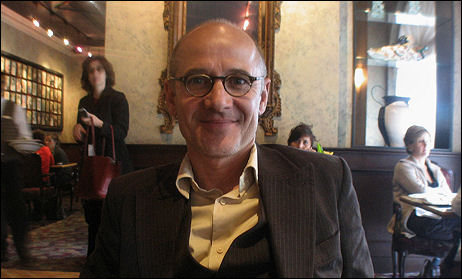
An Academy spokesperson told Us that Renfro’s omission was “an editing decision because we can’t fit everyone in…there was no specific reason.” Well, c’mon. The Academy cut Muhe out because he was German and because they tend to think like xenophobes now and then. Ask anyone in this town who cares about movies what they thought about Muhe’s performance in Florian Henckel von Donnersmarck‘s film (which won the Oscar for Best Foreign Film). One of the film’s more ardent admirers, I read somewhere, is Tom Hanks.
Famed trailer and main-title designer Kyle Cooper (the guy who designed the main-title sequence in Se7en) cut “In Memoriam.” I called his company, Prologue, to ask him about the omissions. He said he didn’t make the choices; Gil Cates’ office did. He was just given a list of names and instructions about who comes first and comes last and that was that. Cates’ assistant said he was out. An Academy spokesperson said the same thing about the p.r. team.
Kimmel + Affleck
Finally…where has this video been hiding? I first ran something about it 10 days ago or whatever.
Maher’s one-liner
“My favorite movie of the year was the one about the heartless con man who’s obsessed with finding oil. Its called No End In Sight.” — Bill Maher on the Huffington Post.

